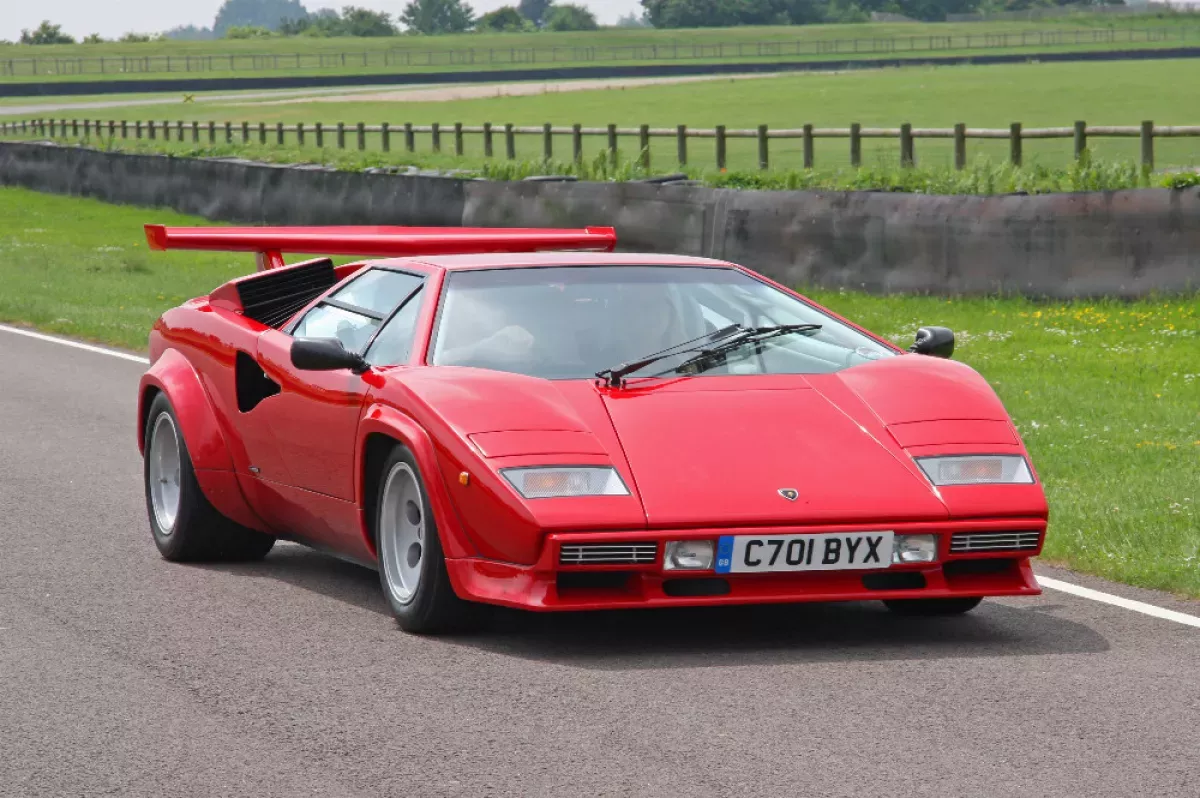The Lamborghini Countach, produced from 1974 to 1990, is a celebrated Italian sports car known for its rear mid-engine, rear-wheel-drive setup. Its distinctive and influential "Italian Wedge" design, characterized by sharp angles, was conceived by the renowned design house Bertone.
1963: Origin of the Lamborghini V12 Engine
In 1963, Giotto Bizzarrini designed the Lamborghini V12 engine. This engine, in various forms, went on to power a succession of Lamborghini models, including the 350 GT, 400 GT, Islero, Espada, and Miura.
March 1966: Lamborghini Miura Debuts
Marcello Gandini's design for the Miura received critical acclaim upon its release in March 1966, establishing his reputation.
1966: Lamborghini Miura Launched
The Lamborghini Miura, the predecessor to the Countach, was launched in 1966 and quickly gained recognition.
1968: Alfa Romeo Carabo Concept Car Introduced
Gandini's exploration of angular design was evident in the 1968 Alfa Romeo Carabo concept car, notably featuring scissor doors later seen on the Countach.
1968: Scissor Doors Debut on Alfa Romeo Carabo
Gandini's innovative scissor doors first appeared on the 1968 Alfa Romeo Carabo concept car, becoming a signature feature of the Countach.
1970: Lancia Stratos Zero Concept Car Showcased
Furthering the wedge-shaped design, Gandini's 1970 Lancia Stratos Zero concept car directly influenced the Countach's styling.
1970: Bertone Commissioned to Design the LP112
Lamborghini tasked Bertone with creating a groundbreaking design for the LP112 project in 1970.
1970: Development of the Countach Begins
Lamborghini, driven by the need to supersede the Miura, started developing the Countach (project name "LP112") in 1970.
1970: Origin of the Countach Name
The name "Countach," an exclamation of astonishment in the Piedmontese language, was chosen for the new Lamborghini model around late 1970 or 1971.
1971: Countach's Design Endures Despite Updates
Despite ongoing modifications throughout its production, the fundamental design of the Countach, first seen in the 1971 prototype, remained largely unchanged over its lifespan.
1971: Countach Chassis Design Evolution
Following tests on the LP500 prototype in 1971, Stanzani's team opted for a complete redesign of the chassis. They chose a full space frame made from welded round-section steel tubing, a technique employed in Formula One at the time, but novel for a road car. This design, significantly stiffer and lighter than the prototype's, became a hallmark of the production models.
1971: Lamborghini's Pursuit of Increased Engine Power
In 1971, Lamborghini's engineering team, led by Paolo Stanzani, sought to enhance the power output of the V12 engine beyond the 279 kW achieved in the Miura SV. Their exploration led them to consider a 5-liter engine displacement to deliver increased power without sacrificing everyday usability.
1971: Countach LP500 Prototype Unveiled
The Countach LP500, the first prototype, was presented to the public at the 1971 Geneva Motor Show, generating significant interest.
1971: Lamborghini LP500 Prototype Debuts
The Lamborghini Countach was first shown to the world as the LP500 prototype at the 1971 Geneva Motor Show.
1971: Debut of the LP500 Prototype at the Geneva Motor Show
The first Countach prototype, the LP500, was unveiled at the 1971 Geneva Motor Show. This car, with several mechanical and stylistic deviations from the eventual production LP400, was instrumental in pre-production testing and development.
1971: Origin of the Countach Name
The name "Countach," an exclamation of astonishment in the Piedmontese language, was chosen for the new Lamborghini model around late 1970 or 1971.
1971: Countach LP500 Prototype Unveiled at Geneva Motor Show
The striking Countach LP500 prototype, with its radical wedge shape and unconventional design, was revealed at the 1971 Geneva Motor Show.
1973: Second Countach Prototype Presented at Geneva and Paris Motor Shows
The second Countach prototype, featuring a design closer to the production LP400, was showcased at the 1973 Geneva Motor Show (in red) and the 1973 Paris Motor Show (in green). This prototype was the first to sport the tubular full spaceframe chassis used in production models.
March 21, 1974: The LP500 Prototype Meets its End in a Crash Test
On March 21, 1974, the LP500 prototype was used in a crash test at the MIRA facility in England to meet European type approval requirements. The car was destroyed during the test.
1974: Introduction of American Safety Regulations
From 1974 to 1981, the U.S. enforced the '5 mile per hour' bumper regulation, which affected the design of imported vehicles like the Lamborghini Countach. This led to modifications in bumper design to comply with safety standards.
1974: Lamborghini Countach Production Begins
In 1974, the Lamborghini Countach entered production. This marked the beginning of an era for the iconic sports car.
1974: Production Launch of the Countach LP400
The Countach LP400 was officially launched for sale at the 1974 Geneva Auto Show, receiving 50 orders. It featured a 3,929 cc engine producing 276 kW of power.
1974: Launch of the Countach LP400 with a 3.9-liter Engine
The first production Countach, the LP400, debuted in 1974 with a 3.9-liter engine due to unresolved durability concerns with the intended 5-liter engine. The engine, designated "L 406," generated 276 kW of power.
1974: Third Countach Prototype Unveiled at Geneva Motor Show
The third Countach prototype, often regarded as the first pre-production or first production LP400 Countach, debuted at the 1974 Geneva Motor Show. It was the first to be fully built at the Lamborghini factory (excluding the chassis). This yellow prototype incorporated the final production LP400 body style and interior design.
1974: Lamborghini Debuts the LP400 Countach
Three years of refinement led to the 1974 debut of the production-ready LP400 Countach.
1975: Creation of Walter Wolf Special
In 1975, Canadian businessman Walter Wolf commissioned Gianpaolo Dallara to create a special high-power version of the Countach, known as the 'Walter Wolf Special.' This model featured a 5.0 L engine, upgraded wheels, Pirelli P7 tyres, flared arches, and spoilers, setting a precedent for future Countach models.
1976: Beginning of the Grey Market Era
Starting in 1976, Americans began purchasing Lamborghini Countachs and modifying them to meet U.S. EPA and DOT regulations. This period, known as the grey market era, saw several European vehicles adapted for U.S. standards.
1978: End of LP400 Production
By the end of 1978, Lamborghini had completed the production of 157 Countach LP400s. The LP400 chassis was constructed by Marchesi, assembled and painted at the Lamborghini factory in Sant'Agata, with engines and transmissions also manufactured on-site. This marked the end of an era for the initial model of the Countach.
1978: Launch of LP400 S Model
In 1978, Lamborghini introduced the LP400 S model. This version featured a slightly downgraded engine compared to the LP400 but had significant exterior changes, including the installation of 345/35R15 Pirelli P7 tyres and fiberglass wheel arch extensions. An optional V-shaped rear wing also became popular among owners.
1978: Presentation of LP400 S at Geneva Motor Show
In 1978, Lamborghini presented the first LP400 S, a part of the 'Wolf Specials,' at the Geneva Motor Show. This model featured the original 5.0-litre engine commissioned by Walter Wolf and marked an evolution in the Countach series.
1978: End of Production for the Countach LP400
Production of the Countach LP400 concluded in 1978, marking the end of the first chapter for this iconic model.
1980: End of Countach Assembly in South Africa
Due to changes in South African import regulations in 1980, requiring a minimum of 66% locally produced content for cars manufactured in the country, the assembly of Countach models by Intermotormakers (IMM) in Cape Town came to an end.
1980: Commission of Twin-Turbo Countachs
In the early 1980s, Lamborghini distributor Max Bobnar commissioned two turbocharged Countachs. Master Technician Franz Albert converted these cars to a twin-turbo configuration between 1980 and 1982, creating unique performance modifications.
1980: Countach as Safety Car
The Lamborghini Countach took on the prestigious role of the safety car for Formula One during the Monaco Grand Prix in 1980.
1982: Completion of Twin-Turbo Countachs
By 1982, the two turbocharged Countachs commissioned by Max Bobnar were completed. These cars were unique due to their twin-turbo configuration and other performance enhancements.
1982: Introduction of More Powerful Engine
In 1982, Lamborghini updated the Countach with a larger 4.8 L engine. Although the bodywork remained the same, the interior saw some changes. This model is sometimes referred to as the 5000 S. A total of 321 units were built.
1982: Introduction of the LP500S with Increased Engine Displacement
The Countach LP500S was introduced in 1982, featuring an enlarged 4.754 cc engine.
1983: Countach Concludes Safety Car Role
After a successful run, 1983 marked the end of the Countach's tenure as the safety car for the Monaco Grand Prix.
1984: Presentation of LP500 S Turbo at Geneva Motor Show
In 1984, Lamborghini presented the LP500 S Turbo, one of the two turbocharged Countachs commissioned by Max Bobnar, at the Geneva Motor Show. This model showcased significant performance modifications and a twin-turbo configuration.
1984: Development of the Countach L150 Prototype Begins
Under the guidance of engineer Giulio Alfieri, development of the Countach L150, a one-off prototype, commenced in 1984. The L150 aimed to introduce a new Countach-based production model with a focus on improved engine cooling, updated styling, and enhanced comfort.
1985: Unveiling of the LP5000 Quattrovalvole with Four Valves per Cylinder
1985 marked the arrival of the Countach LP5000 Quattrovalvole, boasting a 5,167 cc engine with four valves per cylinder, a significant leap in engine technology.
1985: Peak of the Grey Market Era
By 1985, the grey market for importing European cars like the Lamborghini Countach into the U.S. reached its peak, with 66,900 vehicles modified to comply with U.S. regulations.
1985: Introduction of LP5000 Quattrovalvole
In 1985, Lamborghini evolved the Countach engine to 5.2 L with 4 valves per cylinder, naming the new model LP5000 Quattrovalvole. The carburetors were moved to the top of the engine for better cooling, although this reduced rear visibility. Kevlar body panels were also introduced, with some versions featuring a Bosch K-Jetronic fuel injection system.
1985: Introduction of U.S. Specification Model
In 1985, Lamborghini introduced a U.S. specification model of the Countach 5000 QV, which met federal safety and emissions regulations. Changes included larger energy-absorbing bumpers and a Bosch K-Jetronic fuel injection system to comply with American standards.
1985: Lamborghini Introduces the LP5000 Quattrovalvole
In 1985, Lamborghini introduced the LP5000 Quattrovalvole, a significant update featuring a 5.2-liter engine and often referred to as the 5000QV.
1985: Countach QVX Debut
The Countach QVX, a short-lived Group C sports racing car, was built in 1985. It was commissioned by Lamborghini's British importer, David Jolliffe, and featured a Spice Engineering and CC engineering-built chassis with a powerful V12 engine derived from the Lamborghini Countach.
1986: Countach QVX Funding Ends
After a lackluster performance in the 1985 Le Mans race, the Countach QVX was entered again in the 1986 season by its sponsor, Unipart. However, funding for the project soon ran out, and the car was withdrawn from competition.
1987: Countach L150 Prototype Completed, Subsequently Rejected
By 1987, the Countach L150 prototype was fully developed and presented to Lamborghini's CEO, Patrick Mimran. However, Mimran ultimately decided against its production due to cost considerations, favoring a less extensive update with the 25th Anniversary Edition and prioritizing the development of the Diablo concept by Luigi Marmiroli.
1987: Countach Evoluzione Unveiled
Lamborghini introduced the Countach Evoluzione in 1987, a one-off prototype and testbed car. It served as a platform for the engineering team to experiment with new technologies for the Countach's successor. Notable features included a unique chassis, extensive use of composite materials, and the absence of non-essential components for weight reduction.
1988: Launch of 25th Anniversary Countach
In 1988, Lamborghini introduced the 25th Anniversary Countach to celebrate its 25th year. Designed by Horacio Pagani, the model featured significant restyling, including aerodynamic improvements and better airflow from the radiators. Despite being mechanically similar to the 5000QV, it had various enhancements.
1988: Design Influence on Countach Anniversary Edition
In 1988, the Countach Anniversary edition, drawing inspiration from the Evoluzione prototype, incorporated design elements such as composite body panels and integrated air intakes in the lower door sills.
1988: Lamborghini Releases 25th Anniversary Edition Countach
Lamborghini celebrated its 25th anniversary in 1988 with the release of a special edition Countach, known as the Anniversary, marking a departure from the LP- naming convention.
1988: End of the Grey Market Era
The grey market era, during which Americans modified European vehicles to meet U.S. regulations, concluded in 1988. The infrastructure created during this time allowed for the importation of 66,900 vehicles in 1985 alone, including the Countach.
1989: Sale of Countach L150 to Minoru Miura
Following its rejection for production, Patrick Mimran, having acquired the Countach L150 prototype, sold it to renowned Lamborghini collector Minoru Miura in 1989.
1990: End of Countach Production
In 1990, Lamborghini ceased production of the Countach, transitioning to the Lamborghini Diablo. The 25th Anniversary edition, produced until 1990, featured design elements like fin strakes within the rear-intake-ducts openings, akin to the Ferrari Testarossa, which improved engine cooling.
1990: Lamborghini Countach Production Ends
The year 1990 marked the end of production for the legendary Lamborghini Countach, concluding its impressive run.
2017: Lamborghini Polo Storico Begins Recreation of the LP500 Prototype
In 2017, Lamborghini's restoration division, Lamborghini Polo Storico, embarked on a project to recreate the LP500 prototype.
2021: Countach L150 Remains in Miura's Collection
As of 2021, the Countach L150 prototype continues to be a prized possession in Minoru Miura's esteemed car collection.
2021: Lamborghini Revives the Countach Name
In 2021, Lamborghini brought back the Countach name with the release of the Sián-based Countach LPI 800-4, a limited-production hybrid-electric model.
2021: Countach LPI 800-4 Launch
In 2021, to celebrate the Countach's 50th anniversary, Lamborghini revived the iconic nameplate with the launch of the Countach LPI 800-4. This limited-production hybrid-electric model featured a potent naturally aspirated 6.5-liter V12 engine combined with a 48-volt electric motor, showcasing technology derived from the Sián FKP 37.
2021: Public Unveiling of the Recreated LP500 Prototype
The meticulously recreated LP500 prototype was revealed to the public at the 2021 Concorso d'Eleganza Villa d'Este.
Mentioned in this timeline
Africa is the second-largest and second-most populous continent comprising of...
Monaco is a sovereign city-state and microstate located on the...

A car also known as an automobile is a wheeled...
South Africa officially the Republic of South Africa RSA is...
The Monaco Grand Prix is a prestigious Formula One race...

Sport is a diverse realm of physical activities ranging from...
Trending

11 days ago James Gunn Plans Superman Sequel Shooting Soon; Teases 'Peacemaker' Role in DCU.
11 days ago Motorcycle crash in Beloit on Cranston Road: Police investigate single-vehicle incident.

11 days ago Zion: Influencers' Storm, Hidden Trail & East Mesa Hike, Views and Fewer Crowds
11 days ago Qatar Airways and Accenture partner for AI-driven aviation excellence, creating 'AI Skyways'.

11 days ago Ketel Marte's Absence and Day Off Requests Cause Frustration Among Diamondbacks Teammates

11 days ago Jamie Lee Curtis Celebrates 'Freakier Friday' with Fan Event and Lookalike Screening
Popular

Gavin Newsom is an American politician and businessman currently serving...

John Bolton is an American attorney diplomat Republican consultant and...

Jupiter is the fifth and largest planet from the Sun...

Muhammad Ali nicknamed The Greatest was an iconic American professional...

Donald John Trump is an American politician media personality and...

George Soros is a prominent American investor and philanthropist As...
